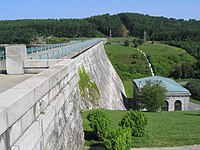Environmental impact of reservoirs

Reservoirs are like big bathtubs that hold water. They are made by building a big wall, called a dam, across a river or stream. When the dam is built, the water behind it can't flow like it used to. Instead, it gets collected in the reservoir.
While reservoirs can be very helpful in storing water for drinking, irrigation, and generating electricity, they can also have an impact on the environment. Here are some ways they can affect the environment:
1. Habitat Loss: When a reservoir is created, the land where the water will go is often flooded. This means that any plants, animals, and insects that lived there will be displaced or even submerged, which can harm or kill them.
2. Water Quality: The water in a reservoir may become stagnant, meaning it's not moving like it would in a river or stream. This can cause problems with the water's quality, such as low oxygen levels, increased algae growth, and more pollutants.
3. Climate Change: When large amounts of water are stored in a reservoir, it can cause changes in the surrounding area's climate. The water may cause humidity, milder temperatures, and more wind in the area where the reservoir is located.
4. Increased Pest Infestation: Reservoirs with stagnant water provide a favorable environment for pests like mosquitoes, which can increase in population and spread diseases.
5. Flooding Threats: Sometimes, heavy rains can fill up a reservoir very quickly, causing it to overflow and flood nearby areas. These floods can be dangerous and may cause damage to homes, crops, and wildlife.
Therefore, while reservoirs can be helpful for many reasons, they can also have some negative impacts on the environment. Managing and maintaining them carefully can help minimize their impact.
While reservoirs can be very helpful in storing water for drinking, irrigation, and generating electricity, they can also have an impact on the environment. Here are some ways they can affect the environment:
1. Habitat Loss: When a reservoir is created, the land where the water will go is often flooded. This means that any plants, animals, and insects that lived there will be displaced or even submerged, which can harm or kill them.
2. Water Quality: The water in a reservoir may become stagnant, meaning it's not moving like it would in a river or stream. This can cause problems with the water's quality, such as low oxygen levels, increased algae growth, and more pollutants.
3. Climate Change: When large amounts of water are stored in a reservoir, it can cause changes in the surrounding area's climate. The water may cause humidity, milder temperatures, and more wind in the area where the reservoir is located.
4. Increased Pest Infestation: Reservoirs with stagnant water provide a favorable environment for pests like mosquitoes, which can increase in population and spread diseases.
5. Flooding Threats: Sometimes, heavy rains can fill up a reservoir very quickly, causing it to overflow and flood nearby areas. These floods can be dangerous and may cause damage to homes, crops, and wildlife.
Therefore, while reservoirs can be helpful for many reasons, they can also have some negative impacts on the environment. Managing and maintaining them carefully can help minimize their impact.
Related topics others have asked about:
